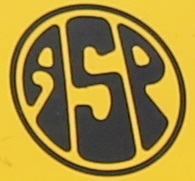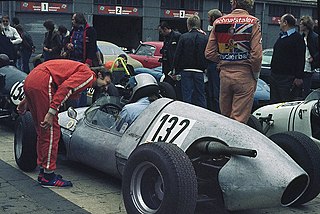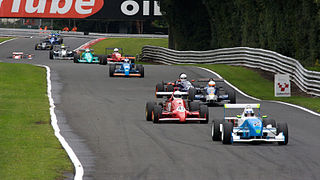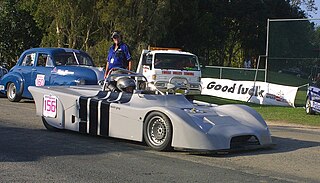
Formula Two is a type of open-wheel formula racing category first codified in 1948. It was replaced in 1985 by Formula 3000, but revived by the FIA from 2009–2012 in the form of the FIA Formula Two Championship. The name returned in 2017 when the former GP2 Series became known as the FIA Formula 2 Championship.
Lola Cars International Ltd. was a British race car engineering company in operation from 1958 to 2012. The company was founded by Eric Broadley in Bromley, England, before moving to new premises in Slough, Buckinghamshire and finally Huntingdon, Cambridgeshire, and endured for more than fifty years to become one of the oldest and largest manufacturers of racing cars in the world. Lola Cars started by building small front-engined sports cars, and branched out into Formula Junior cars before diversifying into a wider range of sporting vehicles.

Alpha Street productions and later Alpha Sports Productions (ASP) were an Australian kit car and racing car manufacturer. It has made sports cars and open wheeler cars. Originally building cars based on the Lotus Seven but have evolved to construct their own distinctive designs.

Nota Sports and Racing Cars is an automobile manufacturer in Australia. The company was founded by Guy Buckingham in 1952. He was an aircraft engineer and used his expertise to build triangulated spaceframed sportscars. Possibly Australia's first space-framed cars. In 1958 the company built a series of all-enveloping aluminium streamlined sports cars. First called "Streamliners", and later called "Mazengarbs". Up to 1960 eleven of those were made. In the late 1950s the company produced Formula Junior cars in both front and mid-engined formats. Nota also made a series of specialist monoposto racing cars for the track and hill climbing events. In 1963 the company made a series of Mini powered sports cars. In 1964 they started production of the Nota Sapphire, an alloy bodied sports and coupe designs with Ford Fiat and Coventry Climax engines. In 1965 Nota started producing Formula Vee cars for Warrick Farm race track making 34 in the first year. In the 1960s the company formulated their "Sportsman", a Lotus 7 lookalike, which they still build today and are now building in a mid-engined version for the modern day transverse engines which the major car manufacturers produce. In 1968 came the Nota Fang Chris Buckinghams first real design, a midengined sports car using a Cooper S engine power plant behind the driver but in front of the rear wheels, their most successful model with over 100 being made. Later the Fang was equipped with Lancia engines, then Toyota engines, finally being fitted with Toyota's V6 Quad cam supercharged engines with over 400BHP. In 1973 Nota started with their Marauder range of cars using the same mechanicals as the Nota Fang. At the same time they were making the Nota Levanti front engine twin cam coupe. In 1975 the supply of Leyland 1275 GT engines started to run out so Nota contacted FIAT and both Marauders and Fangs were made with the 2-litre twin cam FIAT/Lancia engine. Leyland were then approached and the P76 engine was fitted to the Marauders using a Nota made gearbox trans-axle with the gear box next to the driver and the engine behind. In the late 1970s Nota had started on 4WD 351 V8 mid-engined Marauders, but in the 1980s Ford stopped export of the 351 engine to Australia. After a trip to England Chris Buckingham assembled a design team to design a Fang with Fl 3 litre V6 quad cam engine as well as a fully enclosed, similarly specified Chimera. In 2003 Nota developed the Nota Le Mans, powered by either a Suzuki GTi 1300 cc or 1100 cc motor cycle engine. For road use it could also use a Toyota 1800 cc VVTi 6-speed or the 3.5-litre V6 quad cam. By 2012 Nota had decided that due to the lack of front engine rear wheel drive 4 cylinder engine being available they would use an existing front-engined Nota clubman chassis and move the seats forward by 150mm and fit a transverse engine behind the driver. It looks just like their front-engined clubmans but with the advantage of a mid-engined design.

Formula Junior is an open wheel formula racing class first adopted in October 1958 by the CSI. The class was intended to provide an entry level class where drivers could use inexpensive mechanical components from ordinary automobiles. The idea to form the new class came from Count Giovanni "Johnny" Lurani who saw the need of a class for single-seater racing cars where younger drivers could take their first steps. It is often speculated that this class was founded as a reaction to Italy's lack of success in the 500cc Formula Three, and although Italian marques dominated the first year of the formula, they were soon overtaken by British constructors.

Formula 5000 was an open wheel, single seater auto-racing formula that ran in different series in various regions around the world from 1968 to 1982. It was originally intended as a low-cost series aimed at open-wheel racing cars that no longer fit into any particular formula. The '5000' denomination comes from the maximum 5.0 litre engine capacity allowed in the cars, although many cars ran with smaller engines. Manufacturers included McLaren, Eagle, March, Lola, Lotus, Elfin, Matich and Chevron.

Formula Ford, also known as F1600 and Formula F, is an entry-level class of single seater, open-wheel formula racing. The various championships held across the world form an important step for many prospective Formula One drivers. Formula Ford has traditionally been regarded as the first major stepping stone into formula racing after karting. The series typically sees career-minded drivers enter alongside amateurs and enthusiasts. Success in Formula Ford can lead directly to other junior formula series such as a Formula Renault 2.0 and Formula Three, or the W Series for female drivers.

Elfin Sports Cars Pty Ltd is an Australian car manufacturer company that was founded by Garrie Cooper. It has been an Australian manufacturer of sports cars and motor racing cars since 1959.

The Monoposto Racing Club is a single seater, open-wheeled motor racing club in the United Kingdom. Its members race a variety of single seater race cars ranging from 1000cc "Mono Moto" cars to 2000cc Formula Three and Formula Renault cars. Monoposto is Italian for 'Single Seater'. As of 2010, it is the largest single seater championship in the UK, with over 60 regular race entrants.

Formula Ford 1600 is a number of championships which cater to 1600cc, Ford Kent powered Formula Ford racing cars. The UK national Formula Ford category disbanded these cars when it adopted the 1800cc Zetec engine in 1993. However, it has been running as several regional club championships ever since and has recently renewed success. Several cars constructed to Zetec rules have been converted to accept a Kent engine, as well as the Duratec powered cars that followed. There have also been several recent purpose-built Kent cars which have enjoyed success.

Sports 2000 is a restricted-rules class of two-seat, mid-engined, open-cockpit, full-bodied sports-prototype racecar used largely in amateur road racing. Sometimes known as S2000 or S2, the class was developed by John Webb, then of the Brands Hatch racing circuit in England, as an affordable form of sports car racing, essentially a sports car version of Formula Ford 2000. The key attributes of the class were a body design reminiscent of two-liter Group 6 sports racing cars like the Chevron B21 and Lola T-212 but with an ultra-reliable and inexpensive drivetrain comprising a two-liter "Pinto" overhead camshaft engine with very limited allowed modifications and the well-proven, VW-based Hewland Mk 9 transaxle. S2000 aerodynamics continued to evolve beyond their 1970s Group 6 roots, with very 'slippery' cars featuring spats over the wheels becoming the norm.
Group 5 was an FIA motor racing classification which was applied to four distinct categories during the years 1966 to 1982. Initially Group 5 regulations defined a Special Touring Car category and from 1970 to 1971 the classification was applied to limited production Sports Cars restricted to 5 litre engine capacity. The Group 5 Sports Car category was redefined in 1972 to exclude the minimum production requirement and limit engine capacity to 3 litres. From 1976 to 1982 Group 5 was for Special Production Cars, a liberal silhouette formula based on homologated production vehicles.
Formula Rolon, also known as Formula Rolon Chevrolet and later Formula Rolon 2010 is an open wheel single seater Formula Racing car made and raced in India. They run in the single make championships held in the tracks of Coimbatore and Chennai. The car is similar to Formula Asia, and was powered by 1600cc Chevrolet and later Suzuki engines with a racing gear box. The car was launched in Mumbai December 2005 and made its debut in Coimbatore track in September 2006. The 2010 season was its last season as LG Sports announced that it will not enter Formula Rolon for the 2011 season.

The Clubman is a class of prototype front-engined sports racing cars that originated in Britain in 1965 as a low-cost formula for open-top, front-engined roadgoing sports cars like the Lotus 7, which had been crowded out of the mainstream by rear-engined cars such as the Lotus 23.

The British Formula Ford Championship was an entry level single seater motor racing category, designed to give racing drivers their first step into car racing after karting. Drivers from around the world were attracted to the United Kingdom to compete in the series, and successful Formula One drivers such as Ayrton Senna and Jenson Button won their first single-seater titles in the championship. The championship was run to various Formula Ford regulations over the years, based on the engines provided for the championship by Ford Motor Company. These engine based regulations/specifications include the Ford Kent engine, Ford Zetec engine, Ford Duratec engine and in the final years the Ford EcoBoost engine.
Stock car racing in the United Kingdom covers a number of different oval racing formulas. Contact is allowed in UK stock car racing, that is, if you are unable to pass an opponent using speed alone, you are allowed to push or hit your opponent in order to pass. The degree of contact allowed varies between categories.

The Formula Ford Festival is an annual meeting of Ford-powered single-seat racing cars which is held at the end of the British racing season, at the Brands Hatch motor racing circuit in the county of Kent, in Southern England. The events are held over the course of a weekend and although various classes of past and present Formula Fords are present, the high point for many is the championship in which young but skilled drivers from Ford competitions in Europe and beyond race against one another. Often it is a rare chance to compare the skills of drivers who take part in different Ford competitions around the world. Many winners of the festival have gone on to enjoy professional careers in various branches of motorsport - including fourteen who have raced in Formula One.
Colchester Racing Developments produced Merlyn racing cars from 1960 to 1979. The company was founded by Clive Maskrey, Selwyn Hayward and continued by Hayward's brother, Clive. When the manufacture of Merlyn racing cars stopped, Clive Hayward continued to manufacture Merlyn parts as CRD Tool and Engineering Ltd. This company stopped trading in November 2015. Still, Clive Hayward continues to run Colchester Racing Developments, manufacturing Merlyn components and carrying out chassis repairs.
Royale Race Cars was a British constructor of race cars in the 20th century. The company produced single seaters as well as sports cars.
The Australian Clubman, later known as Sports 1300 class catered for small capacity front engine rear wheel drive sportscars initially similar to the road going sports cars such as the Lotus 7 and to other Clubman series internationally. These cars were simple two seat cars based on widely available road car components in a purpose-built space frame chassis and simple bodywork using cycle guards over the front wheels. The basic features of these cars were













